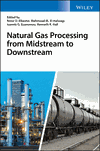 Authors: Epaminondas VOUTSAS¹, Nefeli NOVAK¹, Vasiliki LOULI¹, Georgia PAPPA¹, Eirini PETROPOULOU¹, Christos BOUKOUVALAS¹, Eleni PANTELI², Stathis SKOURAS²
Authors: Epaminondas VOUTSAS¹, Nefeli NOVAK¹, Vasiliki LOULI¹, Georgia PAPPA¹, Eirini PETROPOULOU¹, Christos BOUKOUVALAS¹, Eleni PANTELI², Stathis SKOURAS²
Affiliation: ¹School of Chemical Engineering, National Technical University of Athens, Athens, Greece; ²Equinor ASA, Research & Technology Center, , Trondheim, Norway
Reference (APA): Elbashir, N. O., El-Halwagi, M. M., Economou, I. G., Hall, K. R., Voutsas, E. , Novak, N. , Louli, V. , Pappa, G. , Petropoulou, E. , Boukouvalas, C. , Panteli, E. and Skouras, S. (2019). Thermodynamic Modeling of Natural Gas and Gas Condensate Mixtures. In Natural Gas Processing from Midstream to Downstream (eds N. O. Elbashir, M. M. El-Halwagi, I. G. Economou and K. R. Hall). https://doi.org/10.1002/9781119269618.ch3
Abtract: “Natural gas is one of the major combustion fuels used worldwide with the largest increase in world primary energy consumption. Abundant natural gas resources and robust production contribute to the strong competitive position of natural gas among other resources. Natural gas is a key fuel in the electric power sector and the industrial sector because of its fuel efficiency. It burns cleaner than coal or petroleum products, and as more governments begin implementing national or regional plans to reduce carbon dioxide emissions, they may encourage the use of natural gas to displace more carbon‐intensive coal and liquid fuels….Moreover, UMR‐PRU predictions are comparable to those of the more complex PC‐SAFT EoS. Finally, through the CAPE‐OPEN standards (Computer‐Aided Process Engineering), UMR‐PRU can be incorporated in most process simulators, thus offering the possibility to fully simulate a natural gas treatment process. A case study is presented, which deals with a topside offshore operation that processes a well‐fluid to produce rich gas and stabilized condensate.”
Comments: the authors make the point that the Universal Mixing Rules-Peng Robinson UNIFAC (UMP-PRU) equation of state is accessible in most process simulators through CAPE-OPEN. Worth noting that among the authors, two are with EQUINOR, a company who recently participated in the CAPE-OPEN 2018 Annual Meeting, making there a presentation on their views of CAPE-OPEN. This paper complements the presentation made.
CAPE-OPEN related papers cited in text:
- Belaud, J. P., & Pons, M. (2002). Open software architecture for process simulation: The current status of CAPE-OPEN standard. Computer Aided Chemical Engineering, 10(C), 847–852. https://doi.org/10.1016/S1570-7946(02)80169-9.
